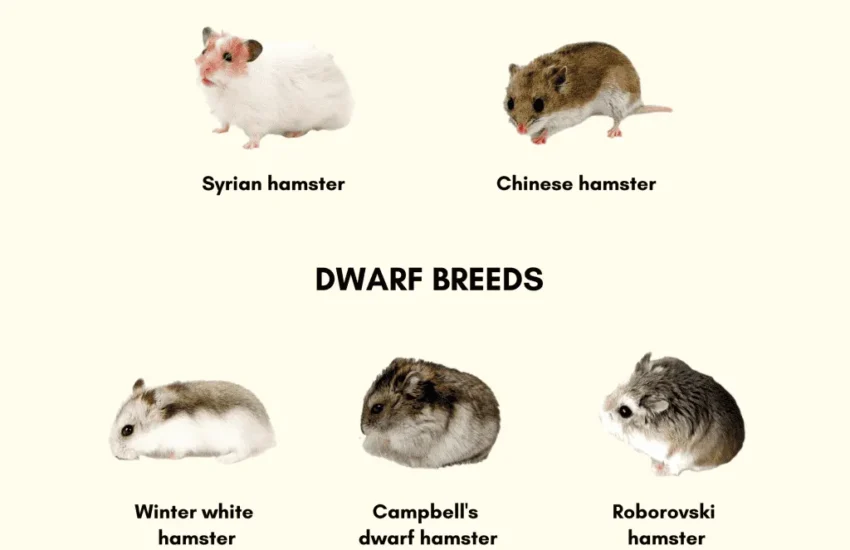Understanding Different Hamster Types
Hamsters are popular pets known for their adorable antics and low maintenance needs. However, not all hamsters are the same; various **hamster breeds** exhibit different characteristics, sizes, and temperaments. In this article, we will explore the various types of hamsters, their unique qualities, and how to care for each breed effectively. We will also provide practical advice to help you choose the best hamster for your lifestyle and preferences. Let’s dive into the fascinating world of hamsters!
Types of Hamsters
There are several types of hamsters, each with distinct traits. The most commonly kept hamsters include the **Syrian hamster**, **Dwarf hamster**, and **Roborovski hamster**. Understanding the differences among these breeds can help potential owners decide which type best fits their needs and environment.
Syrian Hamster
The **Syrian hamster**, also known as the golden hamster, is one of the most popular hamster breeds. They typically weigh between 4 to 7 ounces and have a lifespan of 2 to 3 years. **Syrian hamsters** are solitary animals, meaning they should be housed alone to avoid aggression. Their friendly demeanor makes them ideal for handling and bonding with humans. They are easily recognizable by their fluffy fur, which comes in a variety of colors and patterns.

Dwarf Hamster
**Dwarf hamsters**, as the name suggests, are smaller than Syrian hamsters, usually weighing between 1.5 to 4 ounces. The most common types are the **Campbell’s dwarf hamster** and the **Roborovski hamster**. Dwarf hamsters have friendly temperaments but can be a bit nippy, especially if not handled frequently. While some dwarf hamsters can live together, it’s crucial to monitor their interactions to prevent territorial disputes. These creatures are curious and energetic, making them fun pets for those who enjoy watching their antics.
Roborovski Hamster
The **Roborovski hamster** is the smallest of the hamster breeds, weighing about 1 ounce and living up to 4 years. These hamsters are active and social, often enjoying the company of their own kind. However, they tend to be skittish and may not be the best option for young children. Their small size and quick movements can make them harder to handle. Despite this, they are entertaining pets due to their playful and agile nature.
Choosing the Right Hamster for You
When selecting a hamster, consider factors like your experience level, living space, and how much time you can dedicate to pet care. Each type of hamster has different care requirements, so understanding these aspects will help ensure you provide a suitable environment for your new furry friend.
Space Requirements
The space you can dedicate for your hamster is crucial for their happiness. **Syrian hamsters** need a larger cage than dwarf hamsters, as they require ample space to roam. A good-sized cage should offer a minimum of 24 inches by 12 inches for a Syrian hamster and at least 18 inches by 12 inches for dwarf varieties. Including a wheel, tunnels, and hideouts can enhance their living conditions, encouraging exploration and exercise.
Activity Level and Handling
Consider your activity level and the time you can spend with your hamster. While **Syrian hamsters** are quite social and love interacting with their owners, **Dwarf hamsters** can be a little more aloof. It’s essential to handle them gently and regularly to build a bond. Regardless of the breed, ensuring safe interactions will significantly improve both of your experiences.
Caring for Your Hamster
Caring for hamsters involves more than just providing food and water. Each breed has specific needs that must be met to ensure a happy, healthy pet. Basic care includes diet, enclosures, multi-sensory stimulation, and health monitoring.
Feeding and Nutrition
The dietary needs of hamsters vary slightly by breed. **Syrian hamsters** require a balanced diet of fresh vegetables, fruits, and high-quality pellets to stay healthy. Dwarf hamsters can eat similar foods, but with a reduced amount of fruits due to their sugar sensitivity. Always provide fresh water and avoid feeding them high-fat foods like nuts or seeds, as these can lead to obesity.
Risk of Illness and Health Monitoring
Like any pet, hamsters can suffer from health complications. Common issues include wet tail, diabetes, and respiratory infections. Regularly check your hamster for any signs of discomfort, unusual behavior, or changes in eating habits. A clean cage and proper diet contribute to preventing illness, so maintaining a healthy environment is paramount.
Key Takeaways
- Understand the differences among hamster breeds to choose the right one for your lifestyle.
- Ensure proper space, nutrition, and health monitoring for the well-being of your hamster.
- Regular handling and interaction can foster a strong bond between you and your pet.
- Monitor your hamster’s health closely to catch any potential issues early.
FAQ
1. What is the lifespan of a Syrian hamster?
A **Syrian hamster** typically lives for 2 to 3 years, although some can live up to 4 years with proper care. It’s essential to provide a healthy environment and good nutrition to ensure a long life.
2. Can dwarf hamsters live together?
While some **dwarf hamsters** can cohabitate, especially siblings raised together, monitoring their interactions is vital to prevent territorial disputes and aggression.
3. What should I feed my hamster?
Provide a balanced diet that includes high-quality pellets, fresh vegetables, and fruits in moderation. The diet can vary slightly based on whether your hamster is a **Syrian hamster** or a **dwarf hamster**.
4. How often should I clean my hamster’s cage?
Clean your hamster’s cage at least once a week to maintain a healthy living space. Spot cleaning is recommended more frequently to remove waste and uneaten food.
5. Are hamsters suitable for children?
Yes, hamsters can be suitable pets for children, particularly **Syrian hamsters**. However, supervision and guidance are necessary to ensure gentle handling and care.
